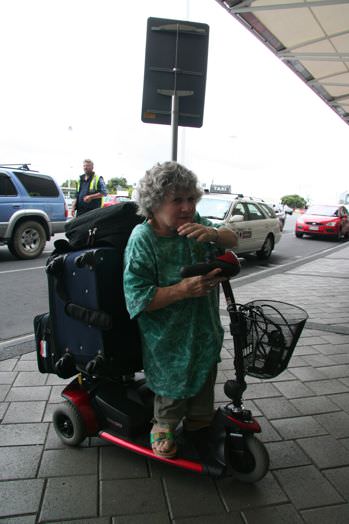
The average person spends about an hour a day waiting. But if you have a disability, waiting only one hour in an airport would be miraculous.
Waiting begins at check-in. Although seat assignments, boarding passes and baggage tags can be issued in advance, mobility devices require in person check-ins to answer safety questions and make departure and arrival arrangements for riding the device to and from the airplane door.
Waiting continues at the airport security checkpoint. Typical passengers reportedly wait 28 minutes in security lines, but people with physical disabilities often wait longer.
Want to subscribe to receive blog updates sign up today?
We wait for someone to lift our carry-on bag onto the conveyor belt and pass a bin in which to place items for scanning or examination. And then we wait for an agent to direct a bypass from the metal detector for a personal pat-down and test for any trace of explosives on our hands or mobility device.
The Transportation Safety Administration (TSA), TSA PreCheck™ program, expedites security inspections with removal exemptions for shoes, belts, light jackets, laptops and 3-1-1 compliant liquids, but travelers and their medical equipment are still subject to imaging and inspection. Plus the TSA PreCheck™ background check, fingerprinting and personal interview are conducted off-site prior to traveling and cost at least $85. Not worth the effort for occasional travelers and definitely a problem for people like me whose fingerprints are no longer legible.
After security clearance, there’s waiting in line for a cup of coffee or a restaurant table. Despite the generous number of stalls, there’s often a line in the bathroom. It’s especially annoying when waiting outside the accessible stall occupied by a nondisabled person changing their clothes and doing hair and makeup. Transit layovers involve lots of waiting in gate lounges and restaurants. Media, meditating/praying in the chapel, people watching, reading, shopping, writing cards and emails, and sleeping fill the time.
People mistake our priority boarding status for less waiting. But when deplaning, they learn we’re last off. We wait for baggage handlers to bring our scooters to the jetway. On a good day, the scooters are brought to us; on a bad day, instructions are ignored, the scooters are delivered to baggage claim, and we must wait for a skycap. Arriving early in the morning or during peak hours means a long wait. For example, when our plane arrived at Heathrow airport in the UK at 5:00 a.m. we had to wait one hour before any transport staff came on duty. The upside is that by the time we make it to baggage claim our bags are either circulating on the carousel or have been off-loaded. The downside is that off-loaded bags are often taken to a storage area where we wait for staff to retrieve them.
Yet those who wait for the Lord Will gain new strength; They will mount up with wings like eagles, They will run and not get tired, They will walk and not become weary.
Isaiah 40:31
To read more, go to my website at https://angelamuirvanetten.com where you can subscribe to my weekly blog and find several retail links to my book, “Pass Me Your Shoes: A Couple with Dwarfism Navigates Life’s Detours with Love and Faith.”

4 replies on “Tired of Waiting In Airports?”
Amazing travail traveling. I never would have known.
Once you know about the waiting, you also know about the need to plan for extra time.
Thank you, Angela for sharing. We take so much for granted, often with total disregard to “little things”, (ie: using the disabled stall) that are necessary for those they are provided for.
Thanks Stephanie. And using the only accessible bathroom stall is not such a little thing when you can’t get into any other stall with your mobility device and a 15 minute wait can cause you to need your own change of clothes and possibly miss your connecting flight.